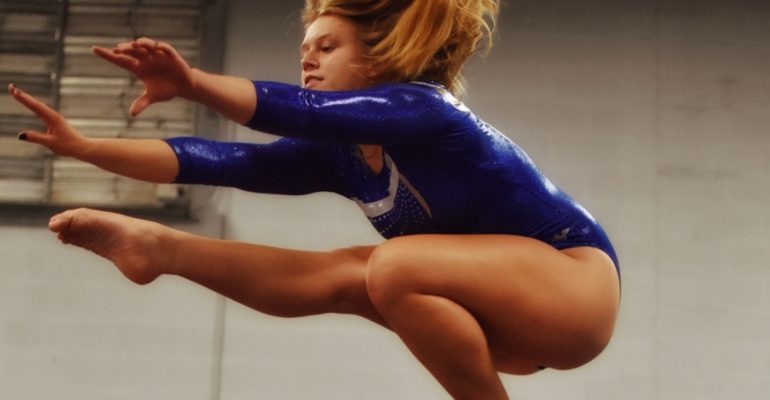A Complete Parent's Guide to When to Start Your Child in Gymnastics
The best age to start gymnastics depends on your child’s unique readiness and competitive goals.
Whether you're looking to build confidence in your toddler, provide an outlet for your energetic school-age child, or help your teenager develop discipline and strength, gymnastics offers great benefits for children at every age.
If your goals are geared more towards competitive performance, starting younger is a benefit… but it’s a myth that you must start your child as a toddler in order to become an Olympic-level gymnast.
By the end of this post, parents will understand:
- The developmental benefits of gymnastics for toddlers, children, and teens.
- How to determine the best age for your child to start gymnastics.
- Tips for finding the right gymnastics program for your family.
Let’s get started.
On This Page
The Physical, Mental, and Social Benefits of Gymnastics for All Ages
Gymnastics builds physical strength, mental discipline, and social confidence for children of all ages.
Gymnastics isn’t just about flips and handstands—it’s a sport that strengthens both the body and the mind.
From toddlers to teens, kids who participate in gymnastics see improvements in flexibility, coordination, and balance, while also developing discipline, perseverance, and self-confidence. Group classes offer a bonus: fostering teamwork and peer encouragement in a supportive environment.
Here’s how gymnastics benefits kids across three core areas:
Physical Benefits of Gymnastics
Strength
Gymnastics is one of the best sports for building full-body strength in kids. The constant use of their own body weight to hold poses, swing from bars, or push off the ground builds powerful muscles across the arms, core, and legs. Over time, this strength not only helps gymnasts master advanced skills but also improves their overall physical health, posture, and athletic performance in other sports.
Flexibility
Flexibility is another cornerstone of gymnastics training, and it’s vital for both performance and injury prevention. Stretching and movement patterns in gymnastics increase joint mobility and muscle elasticity, allowing gymnasts to bend and move with greater ease. Enhanced flexibility isn’t just an athletic asset—it’s a lifelong skill that supports mobility and reduces the risk of injuries as kids grow.
Coordination
From tumbling to vaulting, gymnastics hones a child’s ability to control and synchronize their movements. These activities require gymnasts to develop spatial awareness and balance, which translate to better control of their bodies in everyday life. Improved coordination not only boosts athletic ability but also helps with other tasks like writing, playing instruments, or simply navigating the playground with confidence.
Mental and Emotional Benefits of Gymnastics
Confidence
Few things build self-esteem like achieving a new skill, and gymnastics is full of opportunities for kids to set and reach goals. Whether it’s mastering a cartwheel or conquering their first balance beam, the sense of accomplishment kids feel in gymnastics translates into greater confidence outside the gym. They learn to trust their abilities and celebrate their progress, one milestone at a time.
Perseverance
Gymnastics teaches kids that success often comes from persistence and hard work. Skills in gymnastics are learned step-by-step, requiring practice, patience, and the ability to overcome setbacks. This resilience becomes a valuable life lesson, helping kids approach challenges with determination and a positive attitude, whether in school, sports, or friendships.
Focus
Every move in gymnastics requires concentration, from perfecting a flip to holding a pose on the beam.
By practicing these skills, kids develop a sharper ability to focus on tasks and tune out distractions.
This focus benefits them not just in gymnastics but also in their studies, hobbies, and daily responsibilities.
Social Benefits of Gymnastics
Teamwork
While gymnastics often focuses on individual achievement, group classes and team events help kids learn how to work collaboratively. Encouraging a teammate or celebrating group success fosters an understanding of shared goals and camaraderie. These lessons in teamwork translate into other areas of life, such as group projects at school or playing team sports.
Peer Support
Gymnastics creates a supportive environment where kids cheer each other on and celebrate one another’s progress. The encouragement they give and receive builds a sense of belonging and mutual respect. This positive atmosphere helps kids feel supported, not just by their coaches, but also by their peers.
Community
Beyond individual classes, gymnastics often creates a sense of community among athletes and families. From team competitions to showcases, kids become part of a larger network where they feel connected and valued. This community helps foster lasting friendships and a sense of pride in being part of something bigger than themselves.
From improving physical health to fostering mental growth, gymnastics is a sport that grows with your child, offering new benefits at every stage of development.
Early Gymnastics: What to Know About Ages 3 to 5 Years
Gymnastics for toddlers and preschoolers focuses on motor skill development and building confidence in a playful, low-pressure environment.
Introducing gymnastics at an early age creates a strong foundation for both physical and mental growth.
Gymnastics classes for toddlers and preschoolers are designed with fun and engagement in mind, using games and activities to teach balance, coordination, and basic movements.
These classes also help children begin to navigate social settings and build confidence through small, achievable milestones.
Benefits of Gymnastics for Toddlers and Preschoolers
For children as young as 3 years gymnastics classes nurture essential motor skills like tumbling, climbing, and balancing. Preschool gymnastics classes use fun activities to improve coordination and flexibility, strengthening both small and large muscle groups. Over time, children gain a strong physical foundation that supports their future success in sports and other physical endeavors.
Beyond the physical advantages, early gymnastics encourages emotional development by building self-esteem and confidence. Each small triumph—from crossing a balance beam to completing a somersault—teaches children to tackle new challenges with assurance. The classes’ playful, supportive environment also keeps kids excited about staying active.
Challenges of Starting Gymnastics at a Young Age
Despite these benefits, young children face certain challenges when starting gymnastics. Short attention spans and the need for constant supervision require programs that use brief, varied activities to keep kids engaged.
Structured classes cater to this by using interactive exercises designed to maintain focus and enthusiasm.
Separation anxiety can also occur if parents are not present. To ease this difficulty, many gyms offer parent-and-child classes, helping toddlers feel safe and supported as they learn new skills.
By involving parents, early gymnastics becomes an uplifting experience that encourages comfort and trust.
How to Make Early Gymnastics a Success
Parents can help ensure a positive experience by participating alongside their preschoolers. Selecting programs with small class sizes, certified instructors, and activities tailored to developmental stages creates a nurturing environment. These considerations guarantee that children receive personalized attention while building a solid skill base.
As kids grow more comfortable with the routines, they gain confidence, strength, and coordination that carry over into other areas of their lives.
By choosing the right program and actively supporting their child’s progress, parents can turn early gymnastics into an enriching, joyful part of their child’s growth.
School-Age Gymnastics: Why Ages 6 to 11 Are Perfect for Learning Skills
Gymnastics for school-age children builds foundational skills, strength, and discipline in an engaging and focused environment.
Ages 6 to 11 are often considered the “optimal” time to start gymnastics. These years are ideal for building strength, flexibility, and confidence as kids progress through increasingly challenging skills.
At this age, children are physically developed enough to begin mastering foundational skills, while also benefiting from improved focus and discipline.
Benefits of Gymnastics for Children in Elementary School
At the elementary level, gymnastics refines essential motor skills and builds a strong athletic foundation. Activities like handstands, cartwheels, and rolls improve balance, strength, and coordination.
As kids strive to master new moves, they gain perseverance, discipline, and confidence. By setting clear goals, they learn that steady effort leads to measurable progress.
Challenges to Watch For
Maintaining balance amid schoolwork, other hobbies, and regular practice can prove challenging. Over-scheduling risks burnout, so it’s crucial to keep training fun and manageable.
Frustration may arise when skills take time to develop, testing children’s patience. With encouragement and celebration of small gains, coaches and parents help sustain motivation.
How to Support Your School-Age Child in Gymnastics
Parents can support young gymnasts by establishing a consistent routine that respects both rest and responsibilities. Encouraging at-home practice and acknowledging improvements nurtures confidence.
Selecting a program focused on safety, instruction, and gradual skill growth keeps kids engaged. With proper support, children remain excited, steady in progress, and enthusiastic.
How to Start a Teen in Gymnastics
Gymnastics for teens and tweens focuses on developing discipline, strength, and skills, even for late starters.
While starting gymnastics later may seem daunting, tweens and teens can still experience significant benefits and enjoy classes.
This age group brings more focus and determination to their training, making it possible to develop foundational skills, build strength, and enjoy gymnastics recreationally or competitively.
The Benefits of Gymnastics for Older Beginners
Teens and tweens who start gymnastics often bring curiosity and determination, making it easier to develop strength, flexibility, and mental focus. These improvements benefit not only their athletic abilities but also their academic performance and everyday activities.
Older beginners typically understand effort and progression more clearly, setting achievable goals and appreciating gradual gains. With maturity on their side, even starting at 12 or 13 can lead to substantial personal growth and a meaningful sense of accomplishment.
Challenges of Starting Gymnastics Later in Life
Progress may feel slow at first, as older beginners work on fundamental skills that others mastered years earlier. Rather than comparing themselves to younger peers, focusing on each step forward encourages a positive outlook and steady improvement.
Managing expectations is key. Elite competition might be out of reach, but engaging in showcases or pursuing personal fitness goals can still provide immense satisfaction. With the right mindset, these challenges become stepping stones to growth rather than obstacles.
How to Support Your Teen’s Gymnastics Journey
Encourage teens to value personal development over unrealistic benchmarks. Help them set goals related to strength, balance, or consistency, and remind them that it’s never too late to gain confidence and enjoy the sport’s benefits.
Selecting a program that caters to various ages and skill levels fosters a welcoming atmosphere. With patient coaching, parental support, and a focus on steady progress, older beginners can thrive in gymnastics and embrace a fulfilling, confidence-building experience.
Benefits of Starting Gymnastics Young vs. Starting Later
 Starting gymnastics young builds foundational skills, while starting later fosters focus and maturity.
Starting gymnastics young builds foundational skills, while starting later fosters focus and maturity.
The right age to begin gymnastics depends on your child’s readiness and your family’s goals. Starting young can provide a head start in flexibility, muscle memory, and skill-building.
On the other hand, starting later allows children and teens to bring more focus and intentionality to their training, making significant progress regardless of age.
Advantages of Starting Gymnastics Young
Young children naturally possess flexibility and a fearless attitude, making them quick learners in gymnastics. Beginning at an early age allows them to develop muscle memory and foundational skills while their bodies are still highly adaptable. This early exposure also encourages confidence and discipline, which they can carry into other areas of life.
Gymnastics for toddlers and young kids is typically play-based, so it’s less about competition and more about laying the groundwork for future progress. With consistent practice and age-appropriate instruction, kids who start early often build a solid physical and mental foundation for more advanced gymnastics down the road.
Advantages of Starting Gymnastics Later (Tweens and Teens)
Older children and teens bring a different set of strengths to gymnastics. They often have a better understanding of their goals, allowing them to approach training with focus and commitment. While they may not achieve elite competitive levels, they can still develop impressive skills and enjoy the benefits of the sport.
Starting later also allows teens to set their own pace, focusing on what they want to achieve without the pressure to meet benchmarks set for younger athletes. This self-directed learning fosters a sense of ownership over their progress, building independence and resilience.
So which Is Better, Starting Young or Starting Later?
There’s no one-size-fits-all answer. If your child has the opportunity to begin gymnastics early, they’ll gain physical and emotional benefits that grow with them over time.
If they start later, they’ll bring a level of focus and maturity that accelerates their learning.
What matters most is finding a supportive gymnastics program that nurtures their abilities, wherever they are on their journey.
Common Myths About Gymnastics and Age Debunked
Starting gymnastics is beneficial at any age, and common myths shouldn’t hold parents back.
There are many misconceptions about when a child should start gymnastics or whether starting later limits what they can achieve. Addressing these myths head-on can help parents make informed decisions and feel confident about enrolling their child in the sport, regardless of age.

“You Must Start as a Toddler to Succeed”
Many people believe that starting gymnastics at a very young age is essential for success, but this isn’t entirely true.
While starting young can be an advantage for certain competitive goals, plenty of successful gymnasts began later.
Starting later doesn’t limit what a gymnast can achieve—it simply shifts the focus to personal growth and incremental progress.

“Gymnastics is Unsafe for Children”
Safety is a top concern for parents, but quality gymnastics programs are designed to meet the needs of all ages.
For young children, classes emphasize basic motor skills and low-risk activities, while older beginners are introduced to skills gradually, ensuring they build strength and coordination before advancing.
With trained instructors and proper equipment, gymnastics is a safe and beneficial activity for everyone.

“Gymnastics is Only for Future Olympians”
Some parents worry that gymnastics is too intense unless their child plans to pursue it professionally, but this couldn’t be further from the truth.
Recreational gymnastics focuses on building strength, flexibility, and confidence in a fun, low-pressure environment.
Even for those with competitive aspirations, gymnastics offers more than just the pursuit of medals—it teaches discipline, resilience, and a love for physical activity that benefits kids for life.
Whether your child starts as a toddler or a teenager, the benefits of gymnastics far outweigh any perceived limitations. Choosing a supportive program that prioritizes safety and personal growth ensures that your child has a positive and enriching experience, no matter when they begin.
How to Decide if Your Child is Ready to Start Gymnastics
A child’s readiness for gymnastics depends on their physical development, attention span, and interest.
Determining the best time for your child to begin gymnastics comes down to more than just age. Each child develops at their own pace, and assessing their physical, mental, and emotional readiness is key to ensuring a positive experience.
Parents also play an important role in aligning gymnastics with their child’s interests and goals, whether recreational or competitive.
Physical Development, Attention Span, and Interest
Physical readiness for gymnastics involves strength, coordination, being potty trained, and the ability to follow basic instructions. Younger children may be ready to explore gymnastics through playful activities that develop balance and flexibility, while older children might demonstrate readiness by showing curiosity about gymnastics and the focus to participate in structured classes.
Interest is a crucial factor. A child excited about learning cartwheels or handstands is more likely to enjoy the process and stay motivated. Parents can gauge this by observing their child’s reaction to trial classes or gymnastics-related activities.
Recreational Gymnastics vs. Competitive Gymnastics
Your family’s goals for gymnastics also play a role in deciding when to start. If your child is interested in recreational gymnastics, they can begin at almost any age and progress at their own pace.
For those considering a competitive path, starting earlier provides a longer runway to develop the skills and discipline needed for higher levels.
However, it’s essential to balance ambition with your child’s enthusiasm. A child driven by their own passion is more likely to thrive than one who feels pressured to meet external expectations.
By evaluating your child’s readiness and interests, and aligning them with your family’s goals, you can choose the right time to introduce them to gymnastics. Remember, the most important factor is creating an environment where they feel supported, encouraged, and excited to learn.
What Age is Too Late to Start Gymnastics?
 There’s no age limit for starting gymnastics—older beginners can still gain valuable skills and enjoy the sport.
There’s no age limit for starting gymnastics—older beginners can still gain valuable skills and enjoy the sport.
Parents often wonder if their child has missed the window to start gymnastics, but the truth is that it’s never too late to begin. While early starts can provide some advantages in flexibility and skill-building, older children, teens, and even adults can still benefit immensely from the physical, mental, and emotional aspects of gymnastics.
Older beginners often approach gymnastics with a strong sense of determination and maturity. Teens and pre-teens are typically more focused and motivated to set and achieve their own goals, whether that means mastering a cartwheel or developing strength and coordination.
Starting later also allows participants to fully appreciate the life skills gymnastics fosters, such as discipline, perseverance, and self-confidence. These traits benefit not only gymnastics but also academics, hobbies, and relationships.
Even for those who don’t pursue competition, gymnastics offers universal benefits like improved fitness, flexibility, and mental resilience. Older gymnasts often find joy in mastering new skills and pushing their boundaries in a supportive environment.
There’s no such thing as “too late” in gymnastics.
Whether your child is just starting in their teens or wants to explore the sport for fun, the key is finding a program that supports their goals and nurtures their enthusiasm for learning.
What Makes a Great Gymnastics Program
A great gymnastics program prioritizes safety, skilled coaching, and a welcoming environment for all ages.
Finding the right gymnastics program for your child involves more than just proximity—it’s about ensuring the facility meets high standards for safety, instruction, and inclusivity. A quality gym creates an environment where kids feel supported, safe, and excited to learn, regardless of their age or skill level.
What to Look for in a Gymnastics Facility
Safety should always be the top priority in any gymnastics program. Look for facilities with certified instructors, well-maintained equipment, and clearly outlined safety protocols. A gym that regularly updates its equipment and practices shows a commitment to providing the best environment for its athletes.
Additionally, the variety of class options matters. From parent-and-toddler classes to advanced competitive training, a well-rounded program ensures that your child can grow with the sport. Programs tailored to different age groups and skill levels provide a supportive space for every child to succeed at their own pace.
Gold Medal Gymnastics is the Best Choice for Your Family
Gold Medal Gymnastics sets the gold standard for quality gymnastics programs. With six state-of-the-art locations in New York and one in New Jersey, the facilities are designed to meet the needs of gymnasts at every stage of their journey.
Our certified coaches are experienced in teaching children of all ages, ensuring that classes are both fun and safe. Whether your child is just beginning or aiming for advanced skills, Gold Medal Gymnastics offers a welcoming environment where they can thrive. The program’s dedication to fostering confidence, discipline, and physical fitness makes it a top choice for families across the region.
Ready to get started? Book your first gymnastics class today and kick off your child’s gymnastics journey!
Finding the Perfect Starting Point for Your Child’s Gymnastics Journey
The best age to start gymnastics is the one that aligns with your child’s readiness and goals.
Gymnastics offers unique benefits for children at every stage, from toddlers developing basic coordination to teens building discipline and strength. What’s most important is recognizing your child’s interests, assessing their readiness, and finding a program that supports their journey.
By choosing a facility like Gold Medal Gymnastics & Ninja, you ensure your child will learn in a safe, nurturing environment where their growth is prioritized. With the right support and encouragement, gymnastics can be a fun, transformative experience for any child.



